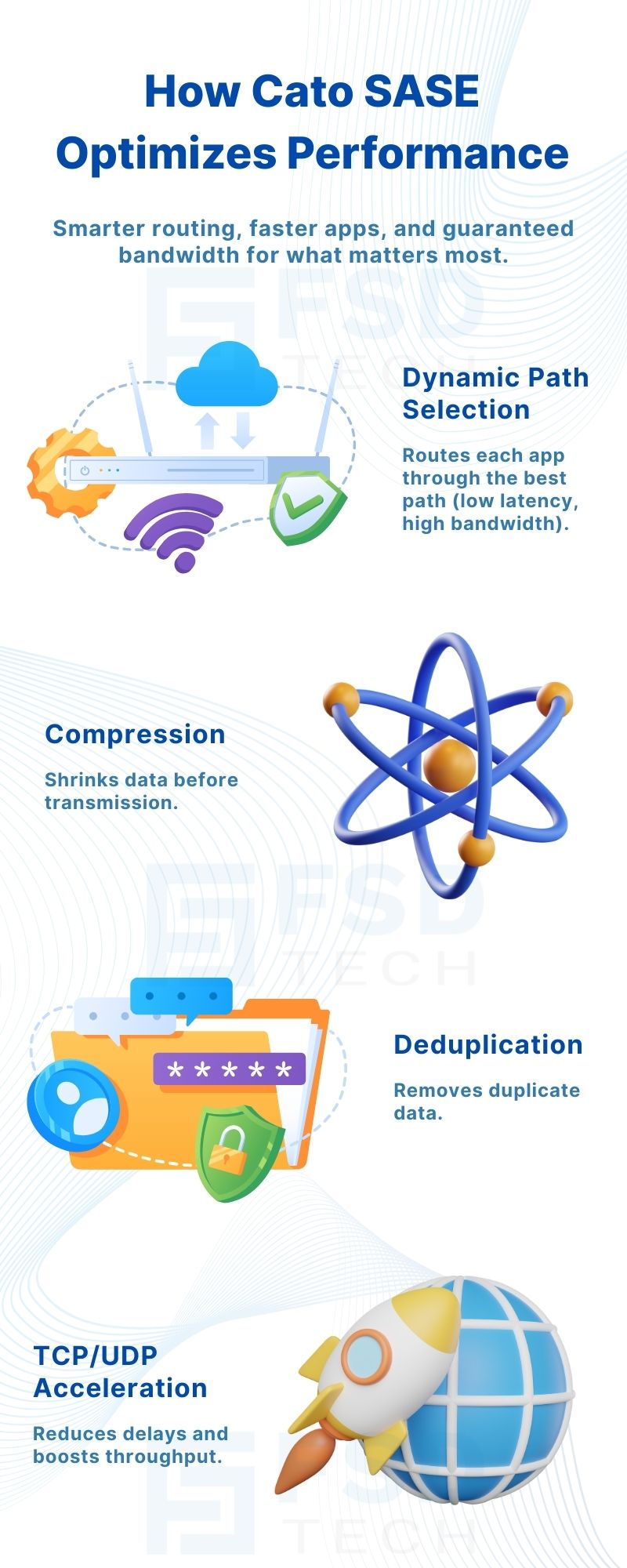
Inside Cato’s SASE Architecture: A Blueprint for Modern Security
🕓 January 26, 2025

Across the UAE and wider GCC, enterprises are under mounting pressure to support bandwidth-hungry applications—HD video conferencing, real-time ERP, large file transfers, and cloud collaboration—without sacrificing speed, reliability, or security. As digital transformation accelerates, the stakes for performance and user experience have never been higher. Yet, legacy WANs and VPNs are increasingly unable to keep up, leading to latency, jitter, and unpredictable application behavior that can disrupt critical business operations.
Traditional network architectures—built on MPLS circuits, hardware appliances, and fragmented security—were never designed for the demands of modern, distributed, cloud-centric business. Backhauling traffic to central data centers introduces latency, while managing multiple point solutions increases complexity and cost. For organizations with branches across Dubai, Abu Dhabi, Riyadh, and beyond, these limitations translate to inconsistent application performance, frustrated users, and operational inefficiency.
Still relying on legacy WAN or MPLS? Discover how modern GCC enterprises are boosting performance with Cato SASE. Get your free assessment today
Cato Networks’ Secure Access Service Edge (SASE), delivered in the GCC by FSD Tech, redefines enterprise networking and security. By converging SD-WAN, advanced security, and a global private backbone into a single, cloud-native platform, Cato SASE enables organizations to deliver secure, optimized access to any application, anywhere.
Unlike legacy solutions that stitch together disparate products, Cato SASE is architected from the ground up for agility, scalability, and seamless integration. This unified approach empowers IT teams to deliver high-performance, secure connectivity without the burden of managing multiple vendors, appliances, or complex configurations.
Modern collaboration platforms—Microsoft Teams, Zoom, Google Meet—are mission-critical for distributed teams but are highly sensitive to latency, jitter, and packet loss. Cato SASE leverages its global backbone and real-time QoS to prioritize video and voice traffic, ensuring clear calls and smooth screen sharing, even during peak periods.
Example:
A Dubai-based financial services firm experienced persistent video call disruptions during regional meetings. After deploying Cato SASE, video traffic was automatically prioritized, latency dropped by over 40%, and conferencing quality became consistently reliable.
ERP platforms (e.g., SAP, Oracle) and large file transfers (CAD files, media assets) require both high throughput and low latency. Cato’s SD-WAN, with built-in WAN optimization (compression, deduplication), accelerates these data flows, reducing transfer times and boosting productivity.
Example:
A manufacturing company in Abu Dhabi needed to synchronize large design files between HQ and remote plants. With Cato SASE, file transfer speeds doubled, and overnight replication jobs completed in half the time.
Remote desktop infrastructure (RDI) and real-time apps—VoIP, trading platforms—demand not only bandwidth but also minimal jitter and packet loss. Cato’s intelligent, application-aware routing and TCP/UDP acceleration ensure responsive sessions, even over variable internet connections.
Cato’s SD-WAN dynamically selects the best path for each application, factoring in latency, packet loss, and bandwidth availability. WAN optimization techniques—compression and deduplication—reduce the data sent over the network, freeing up bandwidth for critical tasks.
Cato SASE inspects traffic at the application layer, routing business-critical apps (ERP, video) over the lowest-latency links, while less sensitive traffic (software updates) uses secondary paths. This ensures high-priority applications always receive the best possible performance.
With real-time QoS controls, IT teams can assign bandwidth guarantees and priorities to specific applications or user groups. Tools like Bandwidth Management and Priority Analyzer provide visibility and control, allowing organizations to adapt policies as business needs evolve.
Example:
A retail chain in Riyadh uses Cato’s QoS to guarantee bandwidth for POS transactions and video surveillance during busy periods, ensuring uninterrupted operations even when guest Wi-Fi usage spikes.
Struggling with video calls, ERP slowdowns, or large file transfers? Learn how Cato SASE optimizes high-bandwidth applications for GCC enterprises. Click Here
Cato’s private backbone, delivered via strategically located PoPs, provides a high-speed, low-latency alternative to the public internet. For GCC enterprises, this means direct, optimized routes between branches, data centers, and cloud services—without the unpredictability of traditional WANs.
Example:
A digital services provider with offices in Dubai, Abu Dhabi, and Doha saw a 50% reduction in application latency after migrating to Cato’s backbone, enabling real-time collaboration across the region.
Cato’s Private PoP capabilities allow enterprises to keep sensitive data within regional infrastructure, supporting compliance with GCC data sovereignty and regulatory requirements. This is especially critical for sectors like finance and government, where data residency is non-negotiable.
FSD Tech works closely with regional enterprises to map out bandwidth requirements, identify critical applications, and understand unique network challenges. This ensures that each Cato SASE deployment is tailored to the organization’s specific needs and business objectives.
FSD Tech configures QoS, traffic shaping, and deduplication/compression thresholds to maximize performance for high-bandwidth applications. Policies are fine-tuned to prioritize mission-critical traffic and adapt to changing business demands.
With Cato’s intuitive dashboards and analytics, FSD Tech provides continuous monitoring, troubleshooting, and optimization—ensuring that applications like ERP, video collaboration, and cloud services run smoothly across all GCC locations.
Boyd CAT, a leading equipment dealer, faced challenges with limited bandwidth and sluggish application performance across its branches. After deploying Cato SASE, the company doubled its bandwidth throughput, gained granular control over update traffic, and saw significant improvements in user experience—all without the cost and complexity of MPLS circuits.
A major retail group with outlets across the UAE leverages Cato SASE (deployed by FSD Tech) to ensure real-time POS transactions, seamless video surveillance, and fast access to cloud-based inventory systems. By prioritizing business-critical traffic and optimizing bandwidth, the chain delivers a consistent, high-quality experience for both staff and customers.
Ready to eliminate bandwidth bottlenecks and unlock high-performance networking? Book a free strategy session with FSD Tech’s experts today.

Cato’s global private backbone minimizes latency and jitter, while real-time QoS ensures video and voice traffic are prioritized. This results in consistently high-quality conferencing experiences for distributed teams across the UAE and GCC, even during peak periods or over long distances.
Yes, Cato SASE provides per-application bandwidth management and Priority Analyzer tools. These allow IT teams to guarantee bandwidth for ERP and other mission-critical applications, ensuring reliable performance even during periods of network congestion.
FSD Tech acts as a regional expert, assessing enterprise bandwidth and application requirements, configuring QoS and traffic shaping policies, setting deduplication/compression thresholds, and providing ongoing monitoring and support. This ensures optimal performance for high-bandwidth applications in the unique GCC network environment.
By unifying networking and security in a single cloud-native platform, Cato SASE eliminates the need for multiple point solutions, hardware appliances, and manual updates. This streamlines operations, reduces costs, and allows IT teams to focus on value-added activities.
Yes, Cato’s Private PoP capabilities allow data to remain within regional infrastructure, supporting compliance with local data sovereignty and regulatory requirements. This is particularly important for industries such as finance, government, and healthcare in the UAE and GCC.
Cato SASE uses WAN optimization techniques like compression and deduplication to accelerate large file transfers. By reducing the amount of data sent over the network and selecting optimal routes, transfer times are significantly decreased, benefiting industries such as manufacturing and media.
Absolutely. Cato’s application-aware routing and TCP/UDP acceleration ensure that latency-sensitive, real-time applications receive the lowest-latency paths and highest priority, resulting in responsive, reliable sessions for users across the GCC.
Cato SASE eliminates the need for expensive MPLS circuits by providing a high-speed, low-latency private backbone. This reduces both capital and operational expenditures, while delivering superior performance and flexibility for modern enterprise applications.
Cato SASE’s real-time QoS and bandwidth management tools allow IT teams to prioritize mission-critical applications and allocate bandwidth dynamically. This ensures that essential business functions—such as ERP, POS, and video conferencing—remain unaffected during periods of high demand.
Cato SASE offers comprehensive dashboards and analytics, giving IT teams real-time insights into application performance, bandwidth usage, and security events. This visibility enables proactive management and rapid troubleshooting across distributed GCC networks.
FSD Tech provides end-to-end support, from initial assessment and planning to deployment, configuration, and ongoing optimization. Their regional expertise ensures that Cato SASE is tailored to the specific regulatory, operational, and performance needs of UAE and GCC organizations.
Yes, Cato SASE is designed for cloud-native environments and integrates seamlessly with public and private cloud platforms. This enables secure, optimized connectivity for hybrid and multi-cloud deployments common in GCC digital transformation initiatives.
By leveraging its private backbone and advanced WAN optimization, Cato SASE minimizes packet loss and ensures reliable, high-performance remote access for users connecting from anywhere in the UAE or GCC.
Industries with high-throughput and real-time requirements—such as finance, manufacturing, retail, and digital services—see the greatest benefits. Cato SASE’s ability to optimize video conferencing, ERP, and large file transfers is especially valuable in these sectors.
Deployment timelines vary based on network complexity, but FSD Tech’s local expertise and streamlined processes enable rapid rollouts. Many organizations see significant performance improvements within weeks of starting their Cato SASE journey.
Yes, Cato SASE’s flexible architecture and regional PoPs support compliance with a range of industry-specific regulations, including those governing data sovereignty, privacy, and security in the UAE and GCC. FSD Tech works with clients to ensure all regulatory requirements are met during deployment and operation.

Anas is an Expert in Network and Security Infrastructure, With over seven years of industry experience, holding certifications Including CCIE- Enterprise, PCNSE, Cato SASE Expert, and Atera Certified Master. Anas provides his valuable insights and expertise to readers.
Share it with friends!
share your thoughts